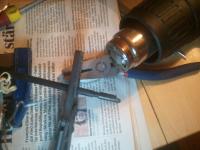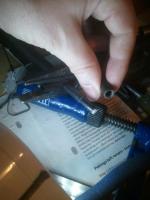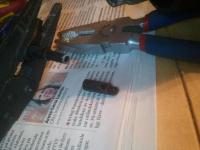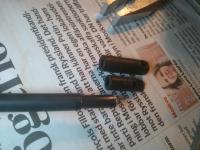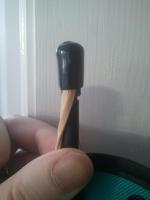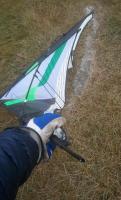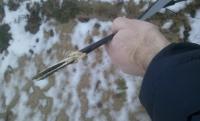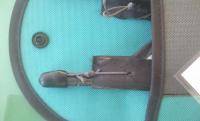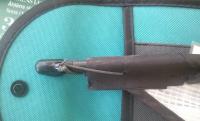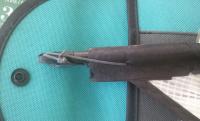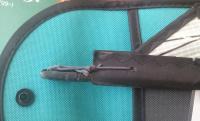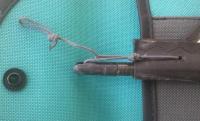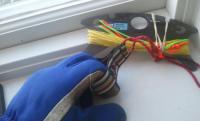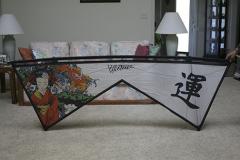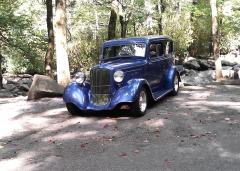-
Posts
580 -
Joined
-
Last visited
-
Days Won
27
Content Type
Profiles
Forums
Gallery
Events
Downloads
KL Shop
Blogs
Articles
Classifieds
Community Map
Everything posted by Exult
-

viral Possibly the most viewed kite video ever!
Exult replied to John Barresi's topic in Kite Videos
This is great and is still great propaganda. The number of views as of today is 1 637 494. Progress, though at a reduced rate. (However, this topic sounds so depressing though actually being a very positive one. Using the construct: "Over a million people exposed to X", I normally would expect X to be something harmful like: asbestos, solvents, DDT, polluted drinking water, bad ergonomics at work, invading slime moulds... Actually I meant no harm to the slime moulds ( https://en.wikipedia.org/wiki/Slime_mold , http://arstechnica.com/science/2010/01/amoeboid-designs-complex-transportation-network-eats-oats/ ). They are actually nice little (non-animal) creatures (of several centimeters dependent upon state) that actually do move/crawl/change shape(!), solve limited navigation problems, have a so to say external memory of where they have been, can be found in humid air conditioners (and haunt you in the sleep... )...like SF but for real) -
Finally I took the time to get both the Hydra and Kymera back on-line. I believe that the nocks came off easier after applying heat with the heat gun, but I was reluctant to test it cold by using much force. Not very much heat was applied so a hairdryer would perhaps have worked as well. What was the glue that was used here (at least there was some on the inner end of the nock)? Would this approach have worked with CA-glue as well? The use of locking pliers and LS-fitting to hold the LLE was OK but perhaps not ideal. A small hose and something wider that these pliers would have been better to distribute the load. On the other hand the required force, at least after heating, wasn't very large. Partially removed Kymera nock after heating with a heat gun. Now I realised how the nocks were attached. Gently pulling with combination pliers worked OK. The Kymera nock is attached over a 6mm carbon fibre tube. Broken nock is now fully removed. The Hydra nock arrangement was very similar to the Kymera's. However a carbon fibre rod was instead the interface here. The old and new nocks were of different outer dimensions, so the new nock needed to be cut and sanded smooth where it had been cut. Measure twice saw once... Perhaps covering the gap with some heat shrink tubing? And I also need to order some bridle line to replace the rubber bands. The fit of the new nocks were so snug so that I decided to try without any glue. You have found the way! I'll never again order just a few caps, nocks, clips... ever. It is so annoying when they are used up! The remaining 6mm nocks I got is even wider than the above spare nocks - I should have ordered more of them.
-
Going multi kiting? Well the demands for preserved feeling through the fingers were quite relaxed for my latest and above session - I was out with my Fazer XXL for the first time. The wrist straps were held with with four fingers (mittens on) through them (similar to @Dodd Gross "wrist" strap style?). I got so warm (centrally, not perifally) from this activity (running back and forth in the snow, using large arm movements and pulling) so I hardly wore the down jacket at all - just a cardigan. A quit rare combo (?) - but function is king. Remember as a child when sailing with the family I often had the almost same arrangement (shorts and a down jacket). When sitting in the cockpit the legs were protected from the wind and often warmed by the sun, while the down jacket protected you from the wind. B.t.w. could the white object in front of you be a 4D? 4D no wind flying, as you know, is good exercise keeping you warm!
-

The Meaning of a Field or The Long Session of Memories
Exult commented on Exult's blog entry in Exult's Gentle Breeze
Some insight only. Flying such a thing myself? - No way José! I prefer to have both my feet on the ground (and don't really like, putting it mildly, any form of roller coasters e.t.c. that my daughters would find at least acceptable). The truly adventurous genes must have skipped one generation. Did try small jumps with a hanglider though a long time ago and permanently decided that it was not for me. Although the feeling (even from these much limited attempts) was out of the ordinary, the risks can never make it worth for me (and it seems to come with large investments and to be much time consuming as well). Come on, I think you might put the threshold too high. Things that are everyday for one person are completely new to another. Things tends to be larger when written down than perceived by oneself during a brief thought. Also consider many people involved in (fictional) arts and literature. The degree of seriousness and attention to details can go over the top there. Why should fragments of real life stories be of less value? Sounds like a civilized rule (shoreline) and a sensible counter action (remote area un-authorized mushroom/wild berry picking...) IMHO. It is neither illegal for a Swedish elk or a Canadian moose to eat huge amounts of blue berries- a few berries in a little basket during a Sunday picnic can't be that terrible. Compared to kiting it was a higher share of preparation and looking forward to the result. You also need to fix things (build mostly) even though you have not broken them first as is often the case in kiting (if you are not into kite building i.e.). (Obvious reflections - yes) Not really - he was more general in areas like this, but not into kiting. Also at the age when I flew my first dual (eighties) it was a small bonus that it was something that my father didn't do. Take yachts for an example, during summers this was the most common thing to do. It was so frequent and natural thing as a child so that it didn't occupy much thought. Sailing yachts and Stockholm's (inner) achipelago can't wow me even today - even though the nature there can be nice (I have already changed my mind; large and strangely shaped rocks far out in the archipelago in any weather and sunsets in red and yellow with water appearing to have a higher viscosity than usual is something extra). And then sailing also required (non-sailing) efforts - maintaining, taking it into and out of the water and occasionally be guarding the boat club during nights. I'm today boat owning FREE allowing my spare time to be less tied up. Perhaps I'm giving room for my daughters to one day find sailing exotic (though we have rented sailing dinghys a couple of times to at least give them some start)? Good luck with this! If it works out this could be a source of OPKs on generous terms. -
Patents - how does it work (question intended to be non-rhetorical)? If a kite innovation is first mentioned in a forum somewhere e.g.. Is it then protected from being patented - permanently and everywhere - or can anyone (or entity), willing to spend enough time and money, patent it anyhow? Can a patent "easily" be invalidated if one can find it mentioned somewhere before it was erroneously granted? To my understanding (hearsay mostly or read about too long time ago - and no, no sources given) patents can be dirty business not working out well for over all evolution/development of product categories/technology or for the individual inventor (getting a patent might cost too much). In the best case it allows for a company to invest resources to develop a (for a limited time) protected product that otherwise wouldn't have been developed at the time. In uglier cases a patent can just be owned and not used to inhibit a competing technology if a company has invested a lot in another but similar technology. Two larger competing companies can also gather many patents as a way to settle score without necessarily going to a court. Judging from some examples little seems to be required (in terms of "height of innovation") for a patent. Long term, there are no indispensable events of innovation (my belief) - innovations/development is a process will spring from the context (technology maturity, a working economy and living conditions of those who can make make innovations) - sooner or later we would have had batteries without Alessandro Volta and we would certainly have mass produced cars without Henry Ford (I again believe). Another "What if" scenario: Where would we be if basic internet technology would have been (software/hardware/principles) patented? Would the technology today be mature/cheap enough host internet forums e.g.? (I am aware of that this, "What if..." (patents), is an old topic - but it tends to never go out of fashion)
-
If it gets cold enough for gloves and a fly the 4D I use the thin gloves and put my index finger through the string loop that hold the finger straps attached to the lines if using the line set that came with the 4D. The finger straps themselves are then inside my hand. When I was out today it was -11 degC (12F). I then used the thin gloves when assembling(/disassembling) the kite and the mittens while flying. When removing the thin gloves when needed (doing lark heads, adjusting the bridle...) have your back against the wind so that the hands are more protected. I also widened the tension of the shoestring in the lower parts of my boot (to allow the air to circulate all the way to the toes), while the upper parts of the shoestring had normal tension (my boots allow this separation of tension along the shoe string). Well insulating underwear is mandatory. But I guess this is nothing new for a fisher.
-
When new to (serious) kiting in the end of nineties I got some (25min?) initial advice there (in the LKS in Stockholm at the time), but found out that the Prism kites then offered was slightly to expensive for me then (I then chose to honor kite selling shops on the Swedish west coast selling HQ kites instead). Life got periods when getting the bacon on the table is the main focus and others when the focus can be more of not to miss out on what life has to offer*. When I started over again with kiting I bought three old kite models (kites that I had drooled over in the past but now could get to a very good price) and one new (4D). After the Stockholm city situated shop closed I've only bought smaller stuff like a Prism tube-tail, The advanced way to fly DVD, higher quality yo-yo for me and as gifts... But would I ever look for a Zephyr (which seem to be highly rated by members in KL) I know where I would go. B.t.w. today I saw that they still offer an Alien according to their web site. I remember when I went there to by a Prophecy at close to 50% discount. He went to the shelf where the kites were kind of inserted, searched and the retracted the hand empty. He said: "Ohh.. it looks like we have sold the last sample unfortunately" He then paused and then looked at me while appearing to picture something for himself and said with a lowered voice: "But it is a fantastic kite" To say that I was disappointed is an understatement . Don't misunderstand me, the shop owner is a very helpful and patient person. However, whenever there is a video with a Prophecy in it, I still prefer to peer hard to make the vision blurry so that I can pretend that instead that there is an Illusion being shown. That was also the kite I ended up buying that day. A few months later, when asked, he never hesitated selling me the three last remaining spare (brittle and discontinued) LLEs (even though the Illusion was the shop owners own favorite) - he just said: "Yes, you may." * What things cost is kind of funny. Today I was at the dentist's because one of my teeth is ruined and that needed a crown/implant (the previous "budget" fix was broken). After 20min (of total 1:45 exhausting hours) they said ohh... we need a pillar as well that is 1500SEK (~150USD) extra. Discussing the matter is hard with lots of stuff in your mouth. This extra sum would correspond to an Echo kite and the total sum, I fear, might correspond to almost two Fazer XXLs (has anyone done this sort of multi kiting?)! There have been occasions when I have had way more fun for my money than I've had today. Also they said until the next visit in three weeks, only eat soft food like porridge and soup. Could this be a way to financially compensate this since porridge is cheap food? Thumbs up for your LKS support SHBKF!
-
I've really considered an Echo to boost the low wind end of my low wind kite armada - currently "only" consisting of a Shadow and a 4D. If I'd discuss the matter with my better half (my wife), the kite purchase quota would currently most likely be used up. Therefore I instead choose to dream and torture myself by watching: https://vimeo.com/6594565
-

Virtual Freestyle Practice, New Camera, and "Push Axels"
Exult commented on Happyspoon's blog entry in Learning to Fly Dual Lines
Take your time with your move and the settling down process. A pause in any activity can also bring fuel for the time when you start again. (I also think that the real estate market would slow down if people really could remember every part of how much work it is to move.) Even if I originally suggested the one handed FA pull (just) here (by no means absolute original), seeing it in the video reminded me of it and made it more clear and "mentally available" for me to bring to the field. You also specified a timing for the fracturing second pull (1/4 through the axel) in the video. Now I can/intend to focus more on the moving forward/catch phase of the FA. Trick discussions are helpful in unexpected ways. Also when seeing this video I notice the fast pace of which you have been learning. I think I said it before that ending the slide by a FA looks good. I've started to try them myself. I also hope your snow crash in the "First Snowfall in Victoria..." wasn't too painful. I recently experienced that ice patches can be hard for your kite's wing tips - but soft snow I can't imagine how you could (destructively) crash a kite in that. But on the other hand, it seemed to be a lot of rubble on the beach.- 7 comments
-
- 1
-

-
- fractured axel
- side slide
-
(and 3 more)
Tagged with:
-
I've only edited videos on two occasions - more like trying it out (cutting, adding text... though the editor is more powerful than this). I had no prior experience and found it reasonably easy to learn enough to get some result (however I need a read up on video (container?) formats and codecs...). I used Openshot (old 1.4.0) ( http://www.openshot.org/ ) on an old Linux distribution for the editing and VLC ( http://www.videolan.org/vlc/index.html ) for converting it to MPEG4. The reason for this is that I don't have the H.264 codec installed on the system (libx264, libmp3lame missing error message), while VLC seems to have that sorted out by itself. The software repositories of my old distro didn't seem to have the required MPEG4 files, but I guess that I could get the corresponding deb-package ( https://packages.debian.org/search?keywords=x264 ) instead. The editing itself in Openshot was not so tricky to figure out by trial and error. Openshot 2.2(current version) is also available for Windows and Mac as well and is free as in beer and speech. If you intend to publish on Youtube it seems like the MPEG2 video codec would do. There is even an export to Youtube option (and other video sites as well) in Openshot. Both Openshot and VLC can save in many different formats and bitrates and frames per second. So my question is if one could make a video small by making it short or lower the quality in a "controlled way" to become a few MB, could one upload it directly to KL? Would a GIF animation be a better choice when e.g. discussing a (part of a) trick? Well my old VLC 2.0.8 can also save files using 14 different codecs (including MPEG4), so if it can open a file it might be able to convert it using the Media > Convert/Save > File > Add... (file). Then press the Convert/Save button. Write the destination file name and chose a profile (will set the codec i.a.). Press "Edit selected profile" icon for even more control, like bit- and frame-rates.
-
(OK quoting myself....) Just found this image of a Topas field card (?) ( https://get.google.com/albumarchive/116200505564645228183/album/AF1QipN6VrqkQHkEqit6NSPhDmnbccBTl6mQgwcR-F_c/AF1QipMCEv62Tm4XMeChCbB6RBdCyTgW2Dsy2qdBC8WE ). I've never seen this detailed tuning recommendations an any of the kites that I've bought. Without the "full" knowledge of a product you don't fully own it. This is definitely a step in the right direction. This is also likely to be educational and invites you to think about the settings and be well prepared when reaching the field. Though not a perfect match it reminds me of the "Maker Bill of Rights" ( http://cdn.makezine.com/make/MAKERS_RIGHTS.pdf ) - read to the very end.
-
From this Atelier Transfer kite video ( https://www.youtube.com/watch?v=FDNH6zj8yKQ ) I'd say: Get yourself a kite and lines that can take it and try to learn to deal with the wind (veeery easy... ). What is shown here is something I didn't expect was possible - this kind of tricking close to the centre of the wind window in these kind of winds. Normally, when the wind increases, tricking takes place closer to the wind window edge instead. Notice the effect of the wind on the pilots and also the speed of the kite. Close to the ground the wind is also lower. Quite recently I flew on a field on the leeward side of a low hill with a hardly detectable slope and experienced a thick ground boundary layer of reduced wind speed - get to know your field to figure out if it offers any possibilities here! When only having access to the 4D in winds that were good for standard kites (but not for the 4D) I discovered that for figure flying triangles were good. Picture one side of the triangle quite close to the ground and the two "ground corners" almost at the edges of the wind window. The last corner is close to the top of the wind window. Everywhere along the path power is now reduced, especially where turning. A trick that is actually helped by non low wind is the sleeping beauty take off. When the kite close to being in the dead launch position with its nose close to the ground the wind helps to lift it up. When being not so far from the centre however, this launch can feel very sudden - first the light flick to spin the kite on the ground, then sweep/pull both arms and then bang fully powered.
-
The Hydra and the Rock of Horror - a Short Cautionary Tale --by Exult (unfortunately) I've lost one protective cap during a session with the Hydra and then before I realised that, I had cracked the split nock (assuming this order of event). This was most likely against a small rock (as seen in the image) when doing a harder 2-point landing or other impact like ground work. Reverse engineering of my own assembly When examining the other remaining wing tip cap and nock I saw that: that there was a crack on the cap and that the string was not tensioned enough (though crack and string tension seem unrelated). I guess that one should monitor the tension in this loop and add a new knot if not tensioned enough. I just assembled it (impatiently) when the kite was new and never thought of it again. I lost both strings and caps on the Kymera during a session and replaced the lost strings with (several turns of) rubber bands that I have in the kite bag. The procedure of assembly for this kite was much the same, I just assembled it and never thought of it again (and I'm not even absolutely sure I did it the right way, but to my understanding it should be in the same way as the Hydra). I certainly did no inspection after the first session. During the latest session I also cracked the (no cap - unprotected) split nock against a patch of ice on frozen ground most likely, since that was the hardest "object" on the field. The Red Ice Kymera - a Hard Story of Chilly Demolition I'm wondering if low temperature is an issue in making the plastic more brittle. I guess that I should always keep the cap on to protect the wing tip and replace it shortly after if it would fall off (why not have the protective caps in bright colour so that it would be easier to see if they fell off?). Also wet clay like soil might not give your protective cap back after a 2-point landing, landing on one wing tip or a tipstab. This happened with my Fazer XL quite recently. The Fazer XL is so heavy so that landing/dragging on a wing tip on a hard ground can quite easily crack an unprotected nock (even if the original nock is very wide). In my case it was a lime stone rock and there were no hard landings involved. Also that, that kite is typically used in heavier wind also increases the risk. (So now I have two good reasons to ask/think about the following - how to remove the old damaged split nock from the LLE?. Should one hold the LLE with pliers (possibly using the LS fitting to make the grip milder) and pull the nock with a second pair of pliers, should one try to let it come loose hitting it with a flick from the back side of a knife (as when removing clips), should one instead use the knife to remove layers of the nock until it is no more or should one give up and buy a new spar for the LLE?)
-
Yes, well I didn't do the naming of the kite (or the, hrm..., colour layout). They do not have a large (L) model though - a marketing decision? I'm also much curious of what tricks that survive (can be transferred) to a kite of this size. Yes, but picture this, after having a work out like session with the Fazer XXL, the wind drops and you assemble a 4D or a Shadow. Would it be possible to quickly re-calibrate your piloting inputs?
-
I'd say HQ Infinity - it got me started or I reached a breakthrough with: lazies, fades and sleeping beauties. It feels "real and serious". However I'm in the somewhat stalled (more precisely nock knocked broken) process of getting acquainted with the Hydra and Kymera so the answer might change with time. But argggg ... the question is so limiting and wind and mood so varying. E.g. when I'm more in kiting for a laugh or a work out (and not the usual/trick precision) I'd go for my Fazer XL (or soon what Santa just brought me in advance today). I'm literally having the package in front of me just now. Recently my wife for the first time in any way questioned my kite purchases, so I think I'll wait until the 24th of December (the date we open the packages here) to seek protection with help from Santa. Hmm... since everyone is asleep i the house I could possibly have a peek and then seal it with some packaging tape... Update: Well, since nobody took a guess, I'll lock me into a wardrobe with my Fazer XXL package to have the unboxing event there and you'll never know...
-
Ich habe es gefunden: http://dradaba.drachenforum.net/detail.php?id=299 ( http://www.kite-tests.de/weihnachten-zu-ostern.html ) The name of the kite is Pure XXL and was designed(/produced?) by a Michael Ryll. Spanwidth: 4.4m. In his shop (Drachenmarkt) they are not (no longer?) offered, but there are several Pure kites on the main image on the index page. In the above Drachenforum page a pilot managed to do a snap stall and a flat axel and endured flying it for 1.5h. In the below videos however, there is no tricking, but instead everything looks very relaxed (tempo i.e. - not force). I wonder how much that is due to tradition among buyers, stamina of pilots (piloting a large kite) or the tricking properties of the kite. In this video a Long Dart (Magnum? - another Günter Wolsing kite), a Pure XXL and a Flaki is flown: https://www.youtube.com/watch?v=68i3U9mqsT0 In this video the Pure XXL makes buggies redundant: https://www.youtube.com/watch?v=AsckWGPiIKg For more large kite drooling go to: http://dradaba.drachenforum.net/search.php and search for: Kategorie: Zweileiner Unterkategorie: alle Spannweite von: 300 cm Spannweite bis: 2000 cm Then press the "Suchen" button.
-
Hmm... Looks handy. However, on very cold days Jack Frost might pinch you hard in the finger tips. However, perhaps you can cover the tips over the finger straps with these gloves (sorry @Happyspoon , when reading through this topic again the day after posting this I then noticed that you kind of already suggested this.) ? Clever idea! I'm sure that one quite rapidly could be spoiled by flying with your finger tips. I really hope that enough of the feeling is preserved through the glove. Perhaps making the glove quite narrow towards the finger tips to reduce play would help? Here is how I handle the finger straps. These thin gloves wont work on very cold days below -5degC (23F). Then I need to resort to wrist straps. If there is need for a kite hat (or rather it's brim) to shield off the sun, a combo of a turtle neck, soft thin cap and kite/sun hat can work. I like SF that provide new thoughts that I'd never would have been able to come up with myself (and of course the story itself must be OK, but that is more difficult to describe). In the beginning of Snow Crash there was a pizza courier on a hover board and some hackers' virtual reality town with the hackers territory in a central place. It was a long time since this was pioneering (perhaps was when originally published). I may be very unfair when judging this book since I didn't finish it. And I know that this is a book that you "should" read. Say about 15-18 years old I read a paper bag full of SF paperback, to a large degree Arthur C. Clarke (one atypical favorite was "Tales from the White Hart"). That helped me a lot with improving my English. Today I have less time (even during my spare time) or competing interests - kiting e.g. most certainly takes much time. In more recent years I have read a few Alastair Reynolds books.
-

The Meaning of a Field or The Long Session of Memories
Exult posted a blog entry in Exult's Gentle Breeze
Sun Oct 16 18:26:55 CEST 2016 GF forecasted 4m/s Hydra on 20m 38kg and 25m 38kg lines Kymera in 25m 38Kg lines This blog entry blobbed and expanded and wouldn't fit into the "chunky log" format any longer, so therefore I broke it out from that log. Although KL is a forum for kiting, kiting always takes place in some kind of a context. In this blog entry I have started from the field and from what I saw and allowed myself to associate memories in one or several steps. It also serves as a personal example of a place of importance. This day I had a quite long session, from the time I first entered the field to the time I finally left nine hours passed (with lunch break however). Afterwards there was a nice exhausted feeling like after a days garden/outdoors work or from winter activities. This cloudy almost dream like autumn weather also helped in bringing back much memories from an area that I've returned to during different phases of my life. The morning session Todays heros - the Hydra and Kymera - I'm still very much in the process of getting acquainted with them. In the background you can see "Filmhuset" (~House of motion pictures/film). There are many film related activities going on here. Part of Stockhom's university institutions, media related, is situated there, there are film archives and library, the film institute is also situated here. They hand out grants to support Swedish film making and distribution. Another activity of theirs is to run the Cinemateket activity. Films that are no longer on the repertoire and are considered to be of interest are shown again here. The most memorable movies that I've seen here are Metropolis by Fritz Lang and "One Flew Over the Cuckoo's Nest" - by Milos Forman. I've seen the latter one four times. One time was in Milos Forman's home country, the former Czechoslovakia republic, during an inter rail trip in Europe 1990 (or was it 1991?). One thing that was different then was that there was an short informational pre-film that to a large extent appeared just to show that people with mental disabilities did exist. I could only speculate on why. The Metropolis version I saw (quite unprepared and didn't really know what to expect) was the Giorgio Moroder tinted version with modern music - This was a hit! For those interested on Youtube there is a Fritz Lang interview ( https://www.youtube.com/watch?v=or0j1mY_rug ) and a documentary about decaying film (the physical celluid strips i.e.), search of Metropolis film fragments around the world, tinting and music ( https://www.youtube.com/watch?v=MaVp1cFERUY ). No no no, this is not a review or a full comparison (it is way too early at this point I'm just not familiar enough with the kites) - just some initial observations. I got some impressions and observed some differences. The Kymera was more a lighter wind flyer with a larger window and the Hydra a trickier kite that encouraged you to toss it around. Even if the Kymera was a good flyer it could easily make a transition into "trick mode". I wonder if part of the well flying properties of the Kymera is due to the billow, this is something that I've not seen in my other kites. If one leave trick/precision kites for comparison for a moment, the billow makes the kite more sail/wing like in appearance. When tossing them around I had several line snags. Both bridles had very long "pig tails" (later learned that they were called leaders) - about a metre (to protect the sail during wrapped flying I suppose). I wonder if the increased mass of these could cause them to be flung outwards around the wing tip? In front of the hill is where I saw the two Tramontana routine by the end of the nineties, that impressed me so much so that I got into kiting seriously. The pink building to the left is called the fortress. From here the king could see how his tropes practiced pitched battles. Much later somewhere here, while my father still was a child, my grand father had been summoned for some home defense activity. He then got a sudden fatal heart (?) failure (why don't you ask for the details when you still can?). The hill to the right of the "fortress" is the most common place you end up in when doing kiting. Unfortunately it is quite popular among dogs as well. Here I imagine is also a place where it was close that I never would have been born. My late father had with a couple of friends built an early hang glider of the Rogallo type. Then my father got towed after a car - a not so healthy activity. I don't know where, but the road makes this place a good candidate. As a small child I saw that creation when being stored in an assembled condition. The fabric was red and white and the frame was made of aluminium. With some imagination similar to the Kymera in the foreground (allowing the grey to represent the aluminum), but with a higher content of red. Cascade Hello World - I've made my first (half axel cascade) using the Hydra, without really being able to make a good proper single half axle (it is that darn pop up move on the second wing tip that refuses (and I've stopped bothering for now) to work for me. Only by pulling on the top wing I did a cascade of seven half axel cycles. No, this should really be 3.5 cycles (takes two half axels to complete a cycle). Could it be so that not giving too much slack can cause some pop up like pull on the wing that ends up highest after the main half axle pull (thus delaying the rixeling of the kite)? Most of the time I flew the Hydra because it was windier than how the forecast usually feels for this field and due to assembly problems of the Kymera (what a disgrace), most likely due to my refusal to RTFM. Even worse, on Youtube there is a recurrent KL video "Dual Line Tutorial - Assembly and Disassembly (stunt kite)" ( https://www.youtube.com/watch?v=AgHexOZ2LRY ). I have frequently got this as a automatic suggestion from Youtube - I have refused to watch this video since I "KNOW" how to assemble a stunt kite - arggg...! Now I need to resort to rubber bands to tension the sail. B.t.w. rubber bands are useful so I always have an abundance of them. Most of the time I use them to keep the lines wound up around the winder and also to keep the LSs and the TS together when the kite is in it's sleeve. I think that the ritual minimises the risk of forgetting a spreader - especially if the kite is disassembled in the dark. Both kites becomes a bit "talkative" in the gusts trailing edge flapping (humming). There are no leech lines in neither kite, but the trailing edge of the Hydra is stiffer and can therefore take more wind since it is made of mylar. On the other hand the Hydra is most likely used when it is more wind... Today the card flips worked out better with the Hydra, possibly due to the heavier frame. For the 540s, the Kymera had a really nice nice feeling (made me think of Jam Session in a way). The lazies felt tricky on the Hydra today, a bit less stable than I remembered from the first (windy/gusty) time I tried it. Later, weeks after this session was finished, I got some more insight into lazies/turtles during some sessions with the Kymera. I experienced that also the Kymera quite easily "de-turtled" during lazies compared to much that I've been flying lately (and more or less leaned the lazy on): Maestro 3, Infinity and Shadow. All the three latter just maintains the turtled position by themselves during the lazy. Kymera is more like that you need to control the turtle pitch by moving forward before initiating the lazy rotation - which means that there are no difficulties in leaving the turtle. There are always always things (aspects of tricking/flying) to investigate. The lunch break The kiting needs to wait for a while - I'm heading for a brunch with my family. During autumn walks I often can't stop myself - I take pictures of large and small things. On the way to the brunch I passed a place where a "crime" once was committed. As a student a long time ago I was being "cheered up" after an acute heart ache (embarrassing now yes) by a friend that arranged an in the forest grill session. He brought some sausages and started a open fire here on the ground to grill them. Now from the part forest rich non-densely populated part of Sweden where he came from starting an open fire on the ground was something perfectly natural to do. However, here to the east of Stockholm 28km^2 of the land is a national urban park (Ekoparken) and it is absolutely guaranteed that you may not have outdoors open fires directly on the ground. There was little wind that day, no leaves on the trees and plenty of smoke to reveal our activities. I wonder how it looked like from the tower? Although the event was started with the best of intention, I then felt double miserable, since I assumed that any remaining cash (the budget of students are often much limited) would need to be spent on fines. Otherwise during no-risk-of-fire periods you may start open fires, well without damaging rocks then. This comes with an even larger "package" - the so called "Allemans rätten" (everyone's right)- you may access even private land. There are several do and don'ts here. Of course you many not enter someones garden e.t.c., log trees and treading on crops. However you may pick berries, mushrooms and flowers provided that they are not rare (defined in lists). You may sleep in a tent (for 24h?) in a place without the land owners permission. There are other things you may not do as well if you don't own the land: take branches/twigs from trees, fishing from (small?) private lakes (including cray fish), tap birch sap ( https://en.wikipedia.org/wiki/Birch_sap )... However lack of parking places can limit access to nature (which may not be in the land owners interest to do anything about). They can change status of land (expensive though) and build houses or place pastures with scary looking horses or cows so that areas are cut off. Nonetheless, he idea of not being allowed (as in other countries) to use your feet to get you "everywhere" feels strange to me. Well what was the topic ...... kites of course . This place is a lot fancier compared to when I visiting as a child (or didn't we just visit the restaurant?). Here my family focus on the important stuff - the dessert and candy. Yes, the tower is kind of a combined broadcasting facility, restaurant and tourist attraction. This area got a lot of embassies and museums. Two of my favorite ones, which I visited a lot as a child, are the National Maritime Museum and the Technical Museum. Outside and to a certain extent inside the Museum) I also learnt to sail during a course with Optimist sailing dinghy, which my mother brought me to (much gratitude). Though the theoretical knowledge how to adjust the sails I got from a poster that happened to be placed in the bathroom of my best childhood friend - you can learn in close to any situation. I never sailed in that bay again, but did visit it much with an inflatable motorized dinghy. Djurgårdsbrunnskanalen/viken (the canal and bay) is a very nice area for walking or going through by boat ( https://en.wikipedia.org/wiki/Djurgårdsbrunnskanalen ). Two years ago me, my youngest daughter and her cousin went to the Technical Museum. That day there was also a maker fair there (so the children got an opportunity to practice some soldering i.a.). So after hours on a museum how do you clear your head efficient when you have a large field nearby? You guessed it - we continued with kiting! Why on earth are there not more days like this? Days like this are not forgotten. Yes this is the place for the action that I've returned to many times. However, before I started seriously with kites I started out non-seriously. To the left there was a non-serious flying competition (still a long time ago). The winner would be the one that amused/entertained the audience and bribed the jury in the best way. I built a large dual line kite of bamboo sticks and black garbage bags. The lines were made of fishing lines. One model rocket was supposed to slide along one of the lines. When it reached the switch in the other rocket should fire downwards long the other line. OK this wasn't perhaps a very healthy activity, but the handles sat on a bar a bit out from me and I wore something looking as a wide construction helmet. How did it go? - not so well, I couldn't control the kite (it actually felt like it turned the wrong way (if that is possible), but I at least got a bottle of sweet arrack liquor (that traditionally go with pea soup on Thursdays https://en.wikipedia.org/wiki/Punsch ) for the idea or as a comforting price? More on rockets: a few years earlier in senior high school I made a project where model rockets were built (but the engines not: https://www.estesrockets.com/ ) and the height was calculated. The computer I had available at the time was my Sinclair Spectrum 48k computer. The program calculated new values of drag, mass and motion every (simulated) 0.01s (a quite arbitrarily number that I didn't do much to investigate the best value of) in the simulation. The most tricky part was launch and the measurement of the actual height. Theory and practice are two different things - there were several difficulties associated with the launch: too little launch current, communication with the helpers that performed the measurement (no we didn't have mobile phones at the time) and that most rockets were tricky to see when the were at their highest. Were did we do the tests - you guessed on the field, a bit more close to the tower than distant from it. Ferry boats to Finland, Åland and Estonia departs from here. Also cargo is handled here. This view makes me think of the last time I saw my first balsa tissue model ( http://2.bp.blogspot.com/-FnPmDSfs0VM/UaCH_uclECI/AAAAAAAACYI/W9x0DTJvqYc/s1600/Sonny.jpg - I could find the drawing - isn't the www fantastic? ) - a free flying glider. The building of it was much assisted by my father, but the model was used, used, repaired, used again (sounds like my Jam Session). The originally white tissue was repaired, then replaced with red tissue, the fin was replaced, the nose weight replaced... I towed it up with the line, it unhooked at it's apogee, but instead of normally gliding downwards some thermal winds must have caught it because it just kept soaring and then set a straight path towards the silos. The last I saw of it was a small red (the original white tissue had been replaced by red in an earlier repair) dot near the top of the Silos. The evening before, the day it disappeared I had made an orange address note in a type writer and put it on the side of the fuselage, but it served no purpose. The morning after, me and my mother took a long walk on the other side of the water to look for the model, but the model was no ware to be seen. The area that now is used for container cargo was until 1952 a bay where sea planes were anchoraged. There was a an airport for seaplanes here with passenger traffic to several destinations. When verifying/reading up on it before posting I got the slightly disturbing info that the name of one of the pilots here was Herman Göring before he made a darker career elsewhere ( http://www.svd.se/harifran-gick-flygen-fore-bromma-och-arlanda-3XQ1 ). Now this should not come as a complete surprise since he found his wife in Sweden. The times were different then my father used to remind me: when buying shoes you could have them X-rayed when testing them, radioactive aftershave was sold and funny ideas about the importance of the color of the hair and how peoples heads were shaped were widespread and accepted. When just being a small child and sitting on the lawn in front of his home my father was suddenly approached by a lady who said: "You don't look so Swedish". He didn't think this was a major thing at the time to my understanding but never forgot it. According to him at this time this was not at all a positive thing to say during this time and was an example of the ideas of that time. If this had anything to do with his dislike of any kind of flag waving, rituals and marches I do not know. At least one time each autumn I try to walk in this area - it gives me a kind of relaxed peace of mind and sense of belonging. Actually I prefer this walk slightly later than this time of year when the treas are even more colorful, possibly even past that peak of color. The moments when I don't have anyone in view it kind of feels like memories from a long time ago are just as valid as recent ones. No you can't say that "there is a dog buried here" - an English corresponding saying is "I smell rat". In fact there are many many dogs buried here. Not only dogs but cats, parrots and a circus horse as well. Continuing the walk in these less crowded parts of Djurgården you eventually reach a bench with a view. If you look closely, close to the centre of the bench/table image on the other side you can see a red building with a green roof. This is Boghammar Marin, a shipyard for medium sized boats - typically no larger than ferry boats for in archipelago traffic. To the right of the shipyard there is a lawn/park just at the sea. There I did my first successful dual line kiting sessions in perhaps 1984 or so. Without any to learn from and no internet I initially and unsuccessfully tried less open fields that had worked for SLKs without any success for this dual. I never progressed beyond figure square flying and hadn't heard of any tricks (and a can't remember if I even made any proper landings)- so I don't count this when answering the "kiting since" question. I still got this kite, though I need to verify that it is complete. Notice the dust layer - this kite has not been flown in about 30 years. About the same time the tanker war had started. The High Speed Patrol Boat was exported in large numbers - civilian equipment yes, but then fitted with weapons. A new term was phrased(/became widely known?) the "boghammers" ( https://en.wikipedia.org/wiki/Boghammar ). Several years ago when going to Stora Karlsö I was surprised to see the Boghammar sign. It turned out that also this ferry boat was made by them. Stora Karlsö ( https://en.wikipedia.org/wiki/Stora_Karlsö or https://sv.wikipedia.org/wiki/Stora_Karlsö ) is situated outside the Gotland coast in the Baltic sea. It previously was a home for the families of the keepers of the light house i.a.. To describe it's nature I'd say that start with Gotland but then make it more extreme: the cliffs, the lime stone formations and the fossils. It is also home for a large share of the population of sea birds (and I'm not thinking of the Seagulls). The reason being the side of the steep cliffs offering so many places for nests. The maximum number of (human) guests at a certain time is limited. B.t.w. when going from Visby to Klintehamn where the ferry boat for Stora Karlsö departures from, you pass the atmospheric kite shop of Drak-Johan. The Afternoon session This version of a snag is something that I haven't seen before. Well if it would be too common I'll remove that label. I was approached by an interested bystander. He was of the rare and much interested type that wanted to know "everything". He was from Portugal and had earlier built and flown 2-line kites. He seemed fascinated by any aspect except possibly for just keeping them in the air. Therefore pointed him to the nearest (nowadays online) store that sells (Prism) kites to get more modern kites and showed him the KL forum. When switching between kites and transferring the lines I continued to explain and mentioned that the name of the knot was larks head in English as well as in Swedish (word by word translation). He then mentioned that he as a child used to hunt larks for food using a slingshot. When I asked if that was no awfully difficult he answered (appearing both humble and proud): "Well, that is not for everyone". The owner of my most frequent lunch restaurant is also from Portugal. According to him he had seen this as a child, but not been involved in it himself. On the other hand he seemed familiar with how the flock responded to the first shot and the delay before you got a second chance. I don't know if any larks live in flocks or if it was so that people then were not so fussy about which species of bird they caught. Power kiting foils is typically the type of kites that you see here. However I haven't as today seen any buggies or land boards as you can't (yes) see in this photo. What I've seen so far is people training how to use the kites. What you can see here is at least the red (to the right) and green (to the left) foils. In school during sports days we sometimes ended up here. On already then old style skates offering little support to the ankles, skating was the activity here. This round track is long and somewhat winding. Though the field appears to be flat, the small slopes gives an interesting aspect to skating. Last year (at least) they also had maintained tracks for cross country skis. By the end of the day when I had finished doing my kiting I'd hoped to talk to the powerkiters and therefore headed in their direction. Hmm... could no longer see any in the dusk. Suddenly I thought I could see a white one instead of the green and red ones. No? Was I mistaken? Then I saw a man walking with a really large back pack and a correspondingly large chunk of fabric. I recognised him before he recogised me. It turned out to be one of the younger of my late fathers former colleges. He explained his activities here today by that he needed to practice handling of the paraglider. The actual use was limited to a few trips each year. He also told me that since he wasn't so large the paraglider was "only" 25m2 (or was it 28m2?). Anyhow with the right technique it seems to be possible to handle really large foils (however here for a different purpose than the kiting). Conclusions for the day, some areas are meaningful and filled with contents, and also that: The land, sea and sky can be used both for wonderful and terrible things! -
For me good weather is over rated - good wind is not. Sun makes the kite difficult to see and your skin hurt (OK being sun pessimistic). Moving around makes one warm as when piloting. If using finger straps chose a pair large enough for your gloves. I've been toying with the idea to make a slit in a mitten and seal it around my tight pair of finger straps. I didn't bother finishing the novel Snow Crash ( https://en.wikipedia.org/wiki/Snow_Crash ), but it is mild for your kite.
-
Observe and give time/make place for the small things so that they can be remembered and utilised at a later time. Skip some digital (passive) time - there is a world to learn/explore. Every day (OK - most days then) is an adventure full of features to investigate. Check them out in your pace (if time allows) so that they fully can be enjoyed and remembered. Be a tourist of your own life. Applied to kiting: During a session if you happen to do a new "kite move"/maneuver (or a new way to induce a transition) that is repeatable - repeat it, vary it, remember it and apply it to other kites. You will most likely learn from the process of varying the move/trick and applying it to another kite. It (a building block?) can one day be part of a sequence, be a way to debug a new trick or make a trick more efficient with less input. Process it in some way to make it available for your next session.
-

Virtual Freestyle Practice, New Camera, and "Push Axels"
Exult commented on Happyspoon's blog entry in Learning to Fly Dual Lines
Another name for "my" push axle could be a backwards/reverse axle (unless already being used for something else). Suggestions for your axel version: push axel, push-spin axel, short-spin axel, short push-spin axel... ?? The above raise the question why are some tricks popular (in attempting), while others are more or less forgotten(?)? E.g. a half axel, to get the second input right when completing the axel I find tricky (though I started to address it again now and then), while a rixel follows naturally from a sloppy overdone input. Yet the half axel is much more common in videos and discussions. Is the rixel not considered tricky enough, only worth doing as a part of a trick sequence (and then not mentioned) or just seen as a failed half axel? Another example is the above reverse/push axel. If you strive for flat axels this could be something to experiment with - when you let one side/wing half sink back the nose will be lowered. In my opinion a trick performed as you mean every part of it looks good. Preferably you also fly between the tricks/sequences as you planned/meant it - yes flying with intent ( http://kitelife.com/kl-archive/tutorials/tutorials-dual-line/flying-with-intent/ ) all over again. The only two exceptions to fly with intent I find is if one just try inputs out without knowing what is going to happen (getting rarer nowadays without saying it is a good thing) and the other is (possibly) if you just practice one trick and quickly just wants to get into position to try it again. On the bonus side is that you get more time/focus on the trick. On the negative side is that if one doesn't work on flying nicely between the tricks one might miss getting the good habit of flying with intent between the tricks. I also try to be clear about when the trick has ended and the figure flying starts (but I guess there might be others with different goals that think otherwise). When just testing input, it often involve a flared position with uncertain exit. Handling the often then tumbling kite is part of the practice for me. Try doing a lazy, but exit a bit early. At least for my Shadow it makes the turtle exits easier. Me to, I also think the this helps me to remember/surface things and make them more available when I reach the field. Putting one's thoughts down in text force you to organise your thoughts, rethink thoughts to remember them, verify your beliefs and also brings up new ideas and connections of facts. What a think I miss out on to some degree is the last step to bring it out to the field (not that I'm out of things to practice though). What about creating a real one for print out and on the field pencil editing? I begun thinking of what I'd like to have on mine.- 7 comments
-
- fractured axel
- side slide
-
(and 3 more)
Tagged with:
-
Hello and welcome (/Hej och välkommen)! Personally I'm into framed kites for tricking/precision at least for 95% of the time, but at least got two foil kites, but no Naisch kites whatsoever (didn't even know what it was until checking it out). However, after sending a spy to Santa Claus I suspect that something large, somewhere between a power/speed/trick kite is waiting for me...
-
-

The Chimneys picnic area in the Smokies
Exult commented on SHBKF's gallery image in Member's Galleries
And as volatile/non-permanent those places of meaning and stability might be, we all appreciate/need them. It can be a certain path (in a wide sense) for walking, a view, a (part of a) museum. Strictly speaking not even (non man-made) places in nature lasts forever - forests can be logged or burn (which is a part of a wildwood forest life cycle) and rocks can demolished or naturally be eroded and washed to the sea. Sometimes the memory of a place will have to do. I'd say that for my places of importance I visit them more frequently in thought than in real life. In a few cases I avoid visiting a place that have been much changed to preserve the memory of a place/period of life - like the house that I grow up in (that is no more). In a way to visit such a place (if it would have been possible) can be less important when you remember every bit of it. I'm lucky, kiting has rather frequently brought me back to a POI (place of importance) that I'm much comfortable in. The place got a "family history", a "history history" (I got old maps that I studied from the area - most from end of the 18th century and onward), a personal history from all periods of life. And I just like that area. Just before publishing this I searched for "Gatlinburg news". When searching in local media on this side of the Atlantic there were only a couple of rows regarding the fire, but of course a tragedy for those involved. Changes may come hard and sudden and I now better understand the tone in your image text. -
@RobB you have made up your mind, you have made a decision, you have parked the kite in a fade, you have made a new home for the kite that it won't leave except when doing a trick(-sequence)! The belly landing and fade launch (at 2:48) are smooth, light and slow - no unnecessary input. At 4:03 there is a half lazy Susan to fade transition. Hm... I thought that is perhaps something to try to learn to use if getting stuck in a turtle. Then I realised you were doing the Jacob's ladder...

